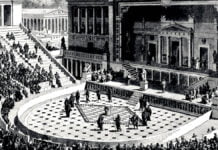A Subaltern is a poem by Siegfried Sassoon, a World War I poet known for his stark representations of the war. As with many of Sassoon’s writings, he focuses on the harsh realities of war and its impact on those participating. The poem provides a glimpse into the harsh realities of war, particularly the experiences of junior officers during World War I. A subaltern is an officer in the British army below the rank of captain. The word can also be used as an old-fashioned synonym for “subordinate.” The title is anonymous and appears impersonal, but the poem that follows is a very human portrait of one person who temporarily lights up the darkness of wartime.
Nostalgia, youth, and the haziness of summer days clash with the unrelenting grimness of war in this portrait of a young subaltern. The subject of A Subaltern is thought to be based on David Cuthbert Williams, a friend of Sassoon and Robert Graves, and inspiration for some of their poems and memoirs. Williams was shot by a German sniper just one week after this poem was published.
Summary
The poem begins with the subaltern standing alone in the darkness of a trench, surrounded by the grim realities of war. He is described as young, fresh-faced, and keen, eager to prove himself on the battlefield. However, as the poem progresses, it becomes clear that disillusionment and despair have replaced the subaltern’s enthusiasm.
The subaltern reflects on the horrors of war, from the relentless shelling to the sight of wounded comrades. He is haunted by the memories of battle, unable to escape the constant fear and uncertainty that pervades his existence. Despite his bravery and resilience, the subaltern is ultimately powerless in the face of the overwhelming forces of war.
As the poem concludes, the subaltern’s thoughts return to his family and loved ones. He longs for the safety and comfort of civilian life, away from the brutality and chaos of the battlefield. The poem ends with a poignant reminder of the sacrifice and suffering endured by those who served in the war, capturing the sense of loss and disillusionment that characterised the experiences of many soldiers during this tumultuous period in history.

Authenticity and Realism
As a World War I veteran, Sassoon brings authenticity and realism to his portrayal of the subaltern’s experiences. He vividly depicts the battlefield’s sights, sounds, and emotions, drawing upon his own firsthand experiences to create a compelling and immersive narrative. This authenticity lends credibility to the poem’s portrayal of war and enhances its impact on the reader.
Exploration of Psychological Impact
A Subaltern delves into the psychological impact of war on the individual soldier, particularly the toll it takes on their mental well-being. Sassoon captures the subaltern’s inner turmoil, from his initial enthusiasm and idealism to his eventual disillusionment and despair. The poem explores themes of fear, trauma, and existential angst, shedding light on the profound psychological effects of combat.
Critique of War
Through the lens of the subaltern’s experiences, Sassoon offers a critique of war and its dehumanising effects. He condemns the senseless violence and destruction wrought by war, highlighting its devastating impact on the lives of soldiers and civilians alike. By portraying the subaltern as a victim of circumstances beyond his control, Sassoon challenges the glorification of war and calls attention to its human cost.
Symbolism and Imagery
Sassoon employs powerful symbolism and imagery to evoke the horrors of war and convey the subaltern’s emotional journey. The darkness of the trench symbolises the bleakness and despair of the soldier’s existence, while the relentless shelling is a constant reminder of the omnipresent danger. Vivid descriptions of wounded comrades and the subaltern’s longing for home create a sense of empathy and emotional resonance with the reader.
Universal Themes
The central theme of A Subaltern is the connections between soldiers and the things that seek to separate them. Soldiers are categorised in the army by rank and regiment and as individuals by experience and background. However, genuine connections exist, and happiness, however fleeting, can be found even in the hellishness of war.
While the poem is set against the backdrop of World War I, its themes of sacrifice, suffering, and disillusionment resonate beyond the specific historical context. Sassoon’s exploration of the human condition in the face of adversity speaks to universal truths about the nature of war and its impact on individuals and societies. The poem is a timeless reminder of the enduring human cost of conflict.
Structure and Form
Sassoon’s use of the sonnet form, a love poem, shows us that despite his inability and reserve about connecting with the subaltern, the bond and affection for him are natural. The poem follows a sonnet’s conventions with its octet, sestet, and iambic pentameter.
A Subaltern is a powerful and thought-provoking poem that offers a compelling exploration of war’s psychological and emotional toll. Through its authentic portrayal of the subaltern’s experiences, Sassoon invites readers to reflect on the human cost of conflict and the enduring legacy of those who have sacrificed their lives to serve their country.





























